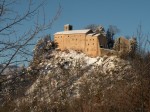 Archaeologists from the regional Archaeological Superintendency of Emilia Romagna restoring the fortress-turned-parish church of the Conversion of St. Paul the Apostle in the small and chilly Apennine mountain town of Roccapelago have discovered 281 bodies piled in a pyramid shape under the church floor. One hundred of the bodies were naturally mummified with skin, tendons, hair, and clothes intact. The people weren’t the only creatures in that crypt to find themselves unexpectedly preserved; rats and larvae were too.
Archaeologists from the regional Archaeological Superintendency of Emilia Romagna restoring the fortress-turned-parish church of the Conversion of St. Paul the Apostle in the small and chilly Apennine mountain town of Roccapelago have discovered 281 bodies piled in a pyramid shape under the church floor. One hundred of the bodies were naturally mummified with skin, tendons, hair, and clothes intact. The people weren’t the only creatures in that crypt to find themselves unexpectedly preserved; rats and larvae were too.
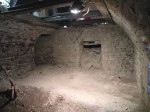 The unusual preservation was due to a confluence of the consistently cold temperature and two slots in the church wall that kept the air constantly circulating. The vaulted crypt — used as an armory when the church was a fortress in the Middle Ages — was first used for traditional inhumation under ground, but the practice later changed to corpses being dropped from a trap door in the church.
The unusual preservation was due to a confluence of the consistently cold temperature and two slots in the church wall that kept the air constantly circulating. The vaulted crypt — used as an armory when the church was a fortress in the Middle Ages — was first used for traditional inhumation under ground, but the practice later changed to corpses being dropped from a trap door in the church.
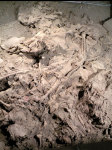 There are several initial layers of bodies which were not well-preserved, probably due to the weight of later burials. The final stack of bodies was covered with a thin coating of pebbles then covered, at the apex of the pyramid, with large boulders. The remains must have already been mummified by then because they were not squashed by the closure of the crypt in the 18th century.
There are several initial layers of bodies which were not well-preserved, probably due to the weight of later burials. The final stack of bodies was covered with a thin coating of pebbles then covered, at the apex of the pyramid, with large boulders. The remains must have already been mummified by then because they were not squashed by the closure of the crypt in the 18th century.
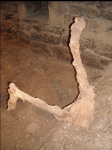 The 300 bodies were buried in the crypt between the sixteenth and eighteenth centuries and probably form the bulk of the population of Roccapelago. Although they were dropped into a mass grave, they weren’t treated disrespectfully. The bodies were all clothed in tunics, hats and heavy socks, some of them wrapped in shrouds, some of them placed in bags. Their heads were wrapped so the jaws wouldn’t gape open, their clothes tied between their legs so their genitals wouldn’t be exposed for all eternity, and their hands folded together as in prayer. Some of them still landed kinda funny, including one fellow who was found doing a headstand with his legs open.
The 300 bodies were buried in the crypt between the sixteenth and eighteenth centuries and probably form the bulk of the population of Roccapelago. Although they were dropped into a mass grave, they weren’t treated disrespectfully. The bodies were all clothed in tunics, hats and heavy socks, some of them wrapped in shrouds, some of them placed in bags. Their heads were wrapped so the jaws wouldn’t gape open, their clothes tied between their legs so their genitals wouldn’t be exposed for all eternity, and their hands folded together as in prayer. Some of them still landed kinda funny, including one fellow who was found doing a headstand with his legs open.
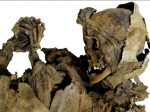 Mass graves don’t usually survive complete with mummified human remains, clothes, and artifacts like lockets and crosses, even a letter; this discovery will allow archaeologists to trace 300 years of social history in the tiny burg. The human remains will reveal infant and child mortality proportions, what kinds of illnesses were endemic, how they ate, how they worked. Researchers are also hoping to be able to determine degrees of consanguinity, a particular interest with such a small community, and how closely related they are to the modern inhabitants.
Mass graves don’t usually survive complete with mummified human remains, clothes, and artifacts like lockets and crosses, even a letter; this discovery will allow archaeologists to trace 300 years of social history in the tiny burg. The human remains will reveal infant and child mortality proportions, what kinds of illnesses were endemic, how they ate, how they worked. Researchers are also hoping to be able to determine degrees of consanguinity, a particular interest with such a small community, and how closely related they are to the modern inhabitants.
Analysis of the body bags, shrouds, clothing fabrics and weaves, plus devotional objects like saint medallions, rosaries and crosses, pollen, animal and vegetable remains will provide an incredibly detailed snapshot of peasant life in the town, their beliefs and traditions, their daily habits, even what the animals ate.
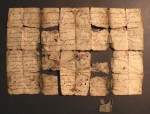 Archaeologists are particularly excited to have recovered a rare “lettera componenda” or “Rivelazione” (aka Revelation), a letter written to God that is basically a contract or deal. They promised prayer in exchange for God’s granting the deceased, in this case a woman, the five graces. These letters were thought to bless the person carrying them in life and when buried with them after death, usually in their hands or in their pockets. This one was found in the false floor of the room, however, so it may have been placed over the lady then covered with earth.
Archaeologists are particularly excited to have recovered a rare “lettera componenda” or “Rivelazione” (aka Revelation), a letter written to God that is basically a contract or deal. They promised prayer in exchange for God’s granting the deceased, in this case a woman, the five graces. These letters were thought to bless the person carrying them in life and when buried with them after death, usually in their hands or in their pockets. This one was found in the false floor of the room, however, so it may have been placed over the lady then covered with earth.
The letter is in need of restoration, but parts of it are already legible. A selection of the readable snippets:
Those who say three Our Fathers and if (…) two Hail Marys every day over the space of 15 years until they finish said number, I will grant them five Graces.
The first I concede them (…) remission of all sins. Second I will not make them submit to the pains of Purgatory.
If the present letter (…) goes to the Holy … Sepulchre in Jerusalem … and he who carries it on him will be free from the Devil and will not die in substance … bad death. Carried it on her the pregnant woman will give birth without danger. In the house where this Revelation lives there will be no illusion of bad things (….) before her death will see the Glorious Virgin Mary Amen.
The letter sounds like the promises made more recently by mortgage bankers (prior to the great recession that is). Also, seeing that poor person’s legs propped up in the air makes a good case for considering cremation–just to know that you would never be found in such a compromising position.
Dammit, I should have just been late to work and read this yesterday.
So many great pictures. They need captions.
I hope the heaven market didn’t crash leaving them with Our Father and Hail Mary equity loss.
For reals. On the other hand, there is something whimsically charming about remaining perpetually mid-cartwheel. It’s a testament to a playful life.
I wholeheartedly endorse playing hooky just to read my blog.
They have hover captions!
“Some of them still landed kinda funny, including one fellow who was found doing a headstand with his legs open.”
Why do you have to say things like that while I’m in the middle of drinking some liquid or other, dammit? :shifty:
At least I didn’t go for the break dancing reference. :giggle:
😆 I think the part I quoted is more subtle, and therefore, more humorous.